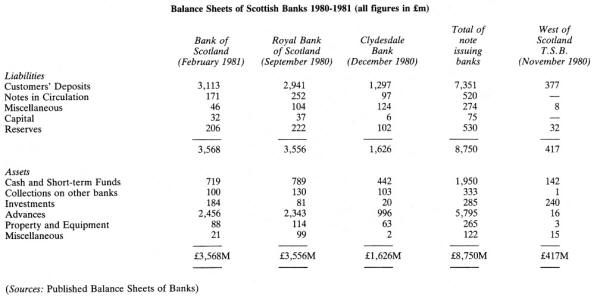The bank balance sheet of today is a very sizeable
and comprehensive document and few people would argue that they should
be made to reveal more information than they, at present, contain. Yet
this has not always been the case. In fact the publication of balance
sheets with related accounts is a late 19th century development. Before
then no banks published their balance sheets although of course all
banks compiled them.
In the very early days of banking the Bank of
Scotland drew up a balance sheet only every three years. It is
impossible to be certain about the Royal Bank for its archives have not
survived for the early years. Yet by the mid-18th century when some of
the early provincial banks were set up it does seem that the standard
practice was to draw up balance sheets at least yearly. Some elements of
these balances—particularly profit figures were read to shareholders at
annual business meetings although they were not published. In this
regard the Scottish banks were ahead of most other forms of business
organisations at the time. One historian speaking of businesses
generally down to 1830 wrote that—
"Balances are struck, not at regular intervals,
as checks and controls, but at the end of books, to save transfers
to new folios." (S. Pollard)
Given that most businesses at the time were simple
partnerships with only a few partners most, if not all of whom, were
involved in management this is not surprising, but many of the banks
numbered their shareholders in scores and management was in the hands of
elected boards of directors. So it was this early joint-stock form of
organisation which made regular reporting necessary; for shareholders
with unlimited liability could not be expected to commit their funds and
bear the risks without receiving some information about the state of
health of their business. There were frequent rows about the amount of
information which should be given to shareholders with directors usually
arguing that it was necessary to be secretive so that information which
they regarded as sensitive did not fall into the hands of business
rivals.
So the early accounts of Scottish banks were shrouded
in secrecy but this reticence on the part of bankers to publish
information has also obscured the very real contribution made by banks
to the development of accounting practice and indeed to the accountancy
profession.
The early development of banking in Scotland
necessitated that elaborate book-keeping systems should be developed and
that books should be balanced at regular intervals. This in fact
happened in banking before it developed in other industries and banks
therefore gave to their clerks a training which was to command high
salaries elsewhere. Many who described themselves as accountants in the
early 19th century had received at least part of their training in a
Scottish bank.
An examination of the archives of 18th century
banking, however, reveals that their were no uniform practices between
banks. Most of the early balance sheets show no attempt to rank assets
and liabilities in any particular order. For example, the balance sheets
of the Perth United Banking Co. from 1767 list balances simply in the
order in which they occur in the ledger but the ledger of the Aberdeen
Banking Company from 1767 shows some attempt to rank balances in order
of liquidity. For example an abridged version of the 1770 balance sheet
reads:—
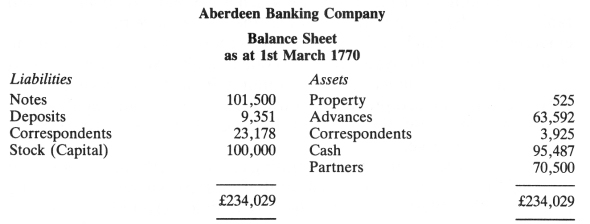
This balance sheet bears a striking resemblance to
its modern day counterpart although a 20th century bank might be
inclined to list the assets in reverse order with the most liquid at the
top. Nevertheless, despite the similarities and despite the great
advance in accountancy which this balance sheet represents it would not
pass the scrutiny of a modern auditor. For example, the Stock (Capital)
balance is the nominal capital and not the paid up figure. To get the
correct figure the reader must subtract the Partners' balance of £70,500
on the assets side which represents uncalled capital. The real figure
for paid up capital is therefore £29,500. The idea of treating uncalled
capital as an asset is one which took a long time to die in the
accountants' world. Similarly the figure for notes is in fact notes
issued to the cashier and not notes in the hands of the public as it
would be in a modern balance sheet. This means that the cash figure on
the assets side is also wrong for it must contain a sum for the bank's
own notes in the hands of the cashier not yet issued to the public.
Fortunately the Aberdeen Banking Co. is one of the few banks for which
it is possible to break down the cash figure into its component parts
and this reveals that the notes and cash figures must be reduced by
£61,782 to get a true picture of the bank's affairs. The balance sheet
can now be redrawn.
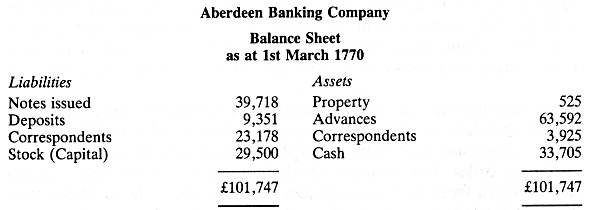
The idea that a bank's own unissued notes could be
part of its cash reserves was one which persisted well into the 19th
century.
The keeping of proper accounts which were regularly
balanced and ranked in order of liquidity was only one of the
developments which emerged in Scottish banking. (It must be recognised,
however, that the claim to be first is always a dangerous one to make.
What is clear is that these accounting practices became common in
Scottish banking before they became standard practice elsewhere.) Other
accounting developments included provisions for bad debts, depreciation
of fixed assets and revenue reserves.
Whatever the advances in accounting techniques the
achievement of the bankers remained concealed until after 1857 when,
following the failure of the Western Bank, the Clydesdale responded to
public comment and began to publish an annual balance sheet. The other
banks followed suit in 1865 but the information given was in a very
truncated form.
Many of the problems which we have mentioned were
overcome by the 1860s when the banks began to publish their balance
sheets. An early report of the Bank of Scotland is reproduced here as an
example of the amount of information which was published. An examination
of this reveals that the problems of unissued notes and uncalled capital
had been overcome but the reader of this balance sheet and the very
brief report on profits and market conditions must have been left with
some unanswered questions in mind. What was the basis of valuation of
the property? Some items in the report suggests that it was not based on
historic cost. If not then what was the historic cost, the amount of
depreciation to date and the present market value? What implications
does this have for the liabilities, especially the reserves? What are
the maturities of the investments in Government securities and
debentures? Without this information the liquid reserve ratio cannot be
calculated. Is the reserve a capital reserve or a revenue reserve?
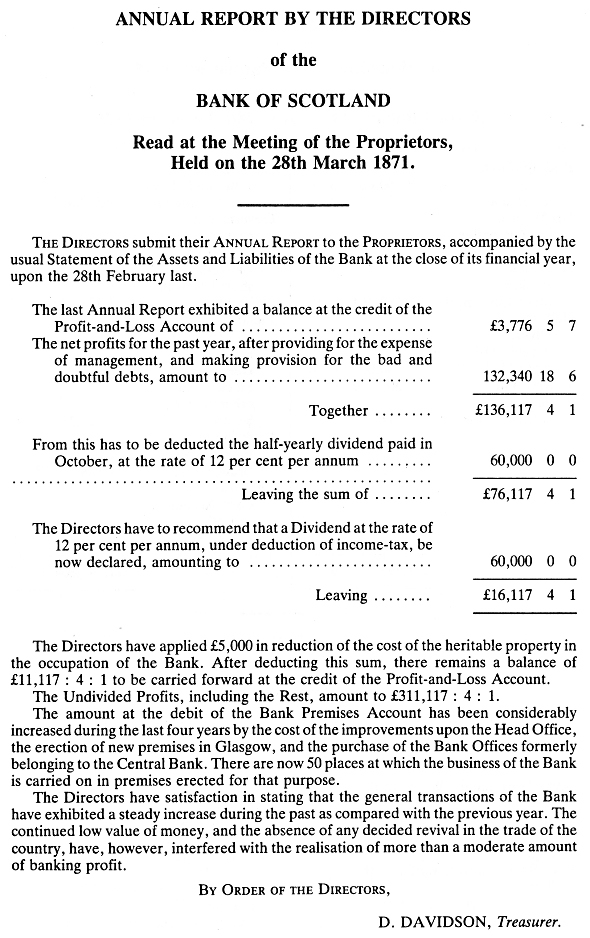
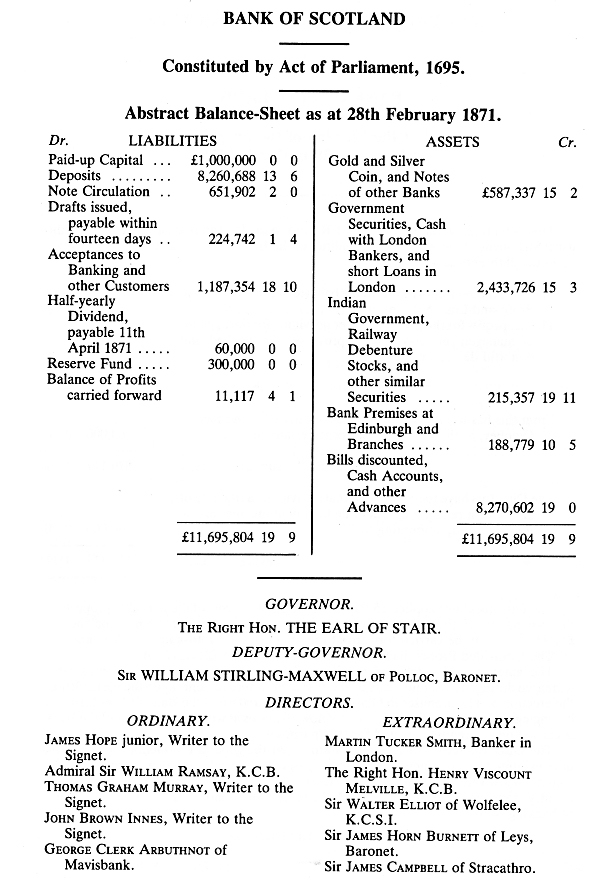
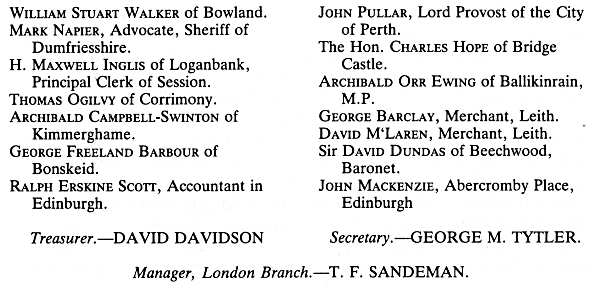
These are only some of the questions which a modern
commentator would ask of the balance sheet. As to the report, even more
questions could be asked of it. What are the elements of income? How
many employees are there? Does the bank plan expansion? Are there to be
changes in the Directorate? What are the principal activities of the
bank? What is the provision for bad debts?
There was always a suspicion that banks did not
declare their true profits each year and that in good years transfers
were made to hidden reserves whilst in bad years these funds were
transferred back to the main profit and loss account so that good
profits could be declared and a regular dividend paid. Indeed this
practice was, to some extent, legally condoned and it was not until 1969
that the practice was ended and banks were forced to disclose their true
profits.
There was no requirement that accounts be audited but
this was introduced voluntarily by all of the banks shortly after the
failure of the City of Glasgow Bank in 1878. From then onwards the
amount of information disclosed in annual reports was gradually
increased either voluntarily or as a result of Companies Acts so that
today the range of information disclosed is very extensive indeed. Most
reports and accounts of Scottish banks now occupy a document of some
forty pages although some of the content is of an advertising nature.
Nevertheless this is a far cry from the two-page document of a century
ago.
Today's reports contain, inter alia, the names
of the directors, head office officials and senior managers. The report
of the directors contains matter which is required to be disclosed by
statute, profit and loss accounts and balance sheets both for the bank
and for the bank plus subsidiary companies, notes of explanation and
elucidation on the accounts, current cost accounts, auditors report and
lists of branches. There may also be a chairman's report and some
descriptive material on the activities of the bank. In short, the modern
report is a weighty and important document which reveals much of the
affairs of the bank. The age of secrecy has receded.
It is not possible to reproduce a copy of a report
here but the table below gives the balance sheets of the three clearing
banks which are then subtotalled. The West of Scotland Trustee Savings
Bank is then included as an example, although it must be borne in mind
that there are three other T.S.Bs at work in Scotland. The West of
Scotland T.S.B. is, however, the largest. A comparison of the figures
for the Bank of Scotland in 1871 and 1981 will reveal just how dramatic
the growth has been in the economy in general and the banking system in
particular. It may seem that there has been little improvement across
the years in the range of figures produced but it must be remembered
that the 1981 balance sheet is supplemented with several pages of
explanatory notes whilst there was nothing to explain the 1871 figures.
